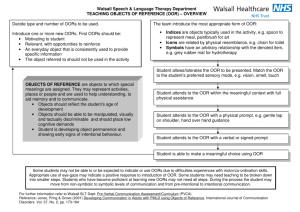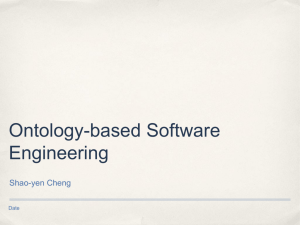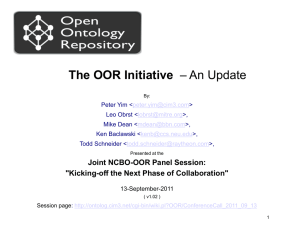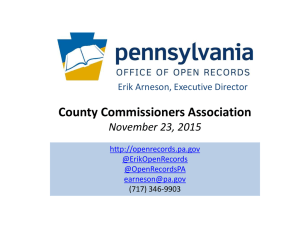OOR-SemTech_Jun2010 - Ontolog
advertisement
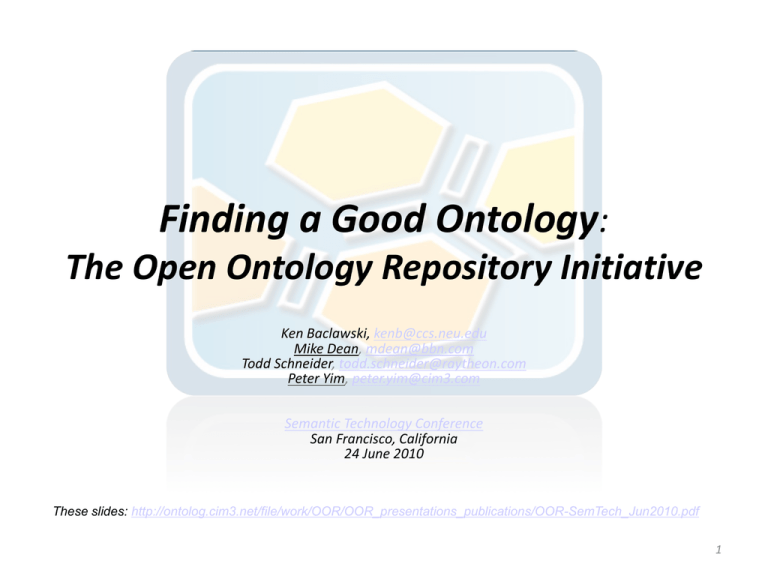
Finding a Good Ontology: The Open Ontology Repository Initiative Ken Baclawski, kenb@ccs.neu.edu Mike Dean, mdean@bbn.com Todd Schneider, todd.schneider@raytheon.com Peter Yim, peter.yim@cim3.com Semantic Technology Conference San Francisco, California 24 June 2010 These slides: http://ontolog.cim3.net/file/work/OOR/OOR_presentations_publications/OOR-SemTech_Jun2010.pdf 1 Outline • • • • • Introduction Demonstration Requirements and Challenges Current Efforts How to Participate 2 Open Ontology Repository • Community effort since January 2008 • Promote global use and sharing of ontologies – Modular open source registry/repository software – 1 or more public instances – Best practices for ontology sharing and management 3 OOR Software Target • Allow modular choices among – Registry functions (search, etc.) – Repository functions (persistence, versioning, etc.) – KR languages (OWL, Common Logic, etc.) – Gatekeeping policies (open, curated, market, etc.) – Intellectual Property Rights policies – Federation mechanisms (OOR, RSS, OMV, etc.) – Value-added services (alignment, translation, etc.) –… 4 OOR Deployment Example Domain 1 Open Source User Ratings Public OOR General purpose Open Source Company Proprietary Curated Domain 2 Proprietary Curated Project Proprietary Open Submission 5 Initial Implementation • Based on NCBO BioPortal – General-purpose ontology repository infrastructure – Supports RDFS/OWL, OBO, and LexGrid – Active user community • Deployed in OOR sandbox and several development sites • Developing Xen-vm and VMware images, as well as installation scripts, for easy deployment 6 Live Demonstration • OOR sandbox – http://oor-01.cim3.net • Selected screenshots included for the archival record 7 OOR Home Page 8 Browsing Ontologies 9 Search Results 10 Ontology Metadata 11 Ontology Mappings 12 Ontology Submission 13 NCBO:BioPortal Ref. NCBO - http://bioontology.org 14 Why OOR? 15 Desirable Properties • • • • • Find ontologies easily Reliably available ontologies Persistent and sustainable source Quality and value - gauged by recognized criteria Supports services – Configuration Management – Mappings - connect ontologies – Alignment - align with mid and upper level ontologies – Search - find and be found – Review/rank 16 Desirable Properties (con’t) • Confidence when committing to use – Ontologies are registered with metadata – Metadata provides • • • • Subject Domain Purpose – Current Uses/Users KR language Originating organization • Information about ontology changes – – – – When Why How Usability 17 Is It Good? • • • • How to assess an ontology as ‘Good’? Different needs require a range of goodness Machines are the primary consumers of ontologies ‘Imports’ create a strong transitive dependency between ontologies • Changes in imported ontologies (directly or nested) can cause resulting import closures to be: – inconsistent – change meanings/interpretations – change computational characteristics • Careful selection and precise reference is critical 18 Provenance • Need provenance to support ‘Goodness’ and trust – Metadata can provide some – More is needed • Documentation – Natural Language descriptions and source references • Expressiveness, Granularity • Intended Uses • Ontology Alignments • Current users/uses • Development Methodology • Development/Change History • Assurance that best practices used – Policies and procedures enforced 19 ‘Goodness’ - Formal Ontology? • Ontologies that allow the most extension require the most rigor (e.g., Upper Ontologies) • More objective representation of a domain (i.e., minimize domain/SME biases) • Allow appropriate levels of granularity • Simplify ontological assumptions • Ease development by deferring to well founded distinctions/classifications 20 OOR Goals • A well-maintained persistent store (with high availability and performance) where ontological work can be stored, shared and accessed consistently; • Mechanisms for registering and “governing” ontologies, with provenance and versioning, made available (logically) in one place so that they can be browsed, discovered, queried, analyzed, validated and reused; • Services across disparate ontological artifacts supporting cross-domain interoperability, mapping, application and inferencing; and • Registration of semantic services to support peer OORs 21 OOR Charter Promote the global use and sharing of ontologies by: – Establishing a hosted registry-repository; – Enabling and facilitating open, federated, collaborative ontology repositories, and – Establishing best practices for expressing interoperable ontology and taxonomy work in registry-repositories. http://OpenOntologyRepository.org 22 OOR Initiative • Started in January 2008 by Peter Yim, Leo Obrst, and Mike Dean • OOR is an independent initiative, emerged from and incubated in the Ontolog Forum's collaborative work environment . • ONTOLOG (a.k.a. "Ontolog Forum") – An open, international, virtual community of practice devoted to advancing the field of ontology, ontological architecture and engineering and semantic technologies, and advocating their adoption into mainstream applications and international standards – http://ontolog.cim3.net/cgi-bin/wiki.pl?WikiHomePage 23 OOR Requirements • The repository architecture shall be scalable. • The repository shall be distributed. • The specification of the repository shall be sufficiently detailed and platform independent to allow multiple implementations. • The repository shall be capable of supporting ontologies in languages that have reasoners [supporting inferencing]. • The repository architecture shall support distributed repositories. • The repository architecture shall not require a hierarchical structure. http://ontolog.cim3.net/cgi-bin/wiki.pl?OpenOntologyRepository_Requirement 24 OOR Architecture • OOR requires an open and well documented architecture to – Allow multiple communities and organizations to participate in the OOR – Produce standard OOR functionalities and behaviors. • OOR Architectural Principles – Decoupling of responsibilities – To support multiple knowledge representations/languages repository will not be there tightly coupled with the content. – Implementation/Platform independence – To support acceptance, multiple instances, and evolution, no particular implementation or platform dependence can be allowed. – Ontologically driven – To allow for evolution of the OOR and reduce overall development costs, the use of an ontologically 25 based development environment is sought. Current Participation • Mailing list with 100+ subscribers worldwide • Between Jan 2008 and now: more than 60 meetings and virtual events (team meetings, invited talks, panel discussions in the form of augmented conference calls) • Featured at major events: OntologySummit2008, ISWC 2009, CENDI/NKOS 2008 & 2009, SOCoP 2009, ESWC 2010, SemTech 2010, ISWC 2010 26 Current Participation (con’t) • Technology contributions from – NCBO / Stanford-BMIR – CIM Engineering (CIM3) – Raytheon BBN – Northeastern University – University of Toronto – University of Bremen – … (more – Your Organization?) 27 Current Participation (con’t) • Contributing to the discourse: communities and projects like BioPortal, ORATE, COLORE, NEU-Courses, SIO, XMDR, MMI, NeOn, SOCoP, … and dozens of individuals from the ontology, semantic web, data modeling, enterprise architecture and software engineering communities 28 Organizing the Effort • Design, architecture - Virtual panels sessions on Requirements, Use Cases; bi-weekly team conf calls; email list • Technology - Open source project (in the style of Apache) • Content - Looking for “content” down two tracks: – The more “traditional” ontologies (in RDF, SKOS, OWL, KIF, CLIF, etc.) – From the communities developing KOS/NKOS, classification schema, taxonomies, XML vocabulary & schema, database schema, etc. • Discourse on Issues - e.g. IPR for ontologies and ontology repositories and registries 29 Ongoing Efforts • Standing up an OOR-sandbox instance (Stanford/CIM3/NEU) http://oor-01.cim3.net/ontologies • Standing up an OOR code-repository (BBN/NEU) - http://oor.semwebcentral.org/ • Positioning to stand up an OOR-production instance, which requires to be in place – Gatekeeping mechanisms – Proper policies 30 Ongoing Efforts (con’t) • OOR-development instances – NCBO: BioPortal - Stanford U. / Mark Musen, Natasha Noy, et al. - whose technology we are running, as our code-base – NEU: gatekeeping and policy dev - Northeastern U. / Ken Baclawski, et al. - via a Use Case Description Ontology (UCDO) – Raytheon BBN: federation - BBN / Mike Dean, Jim Chatigny, Dan Cerys – others: Bremen, MMI, Ryerson, MetHet, ORNL, ... 31 Ongoing Efforts (con’t) COLORE – Common Logic Ontology Repsitory –U of Toronto / Michael Gruninger –First order logic support for OOR –Modularization 32 Ongoing Efforts (con’t) HeTS – the Heterogeneous Tool Set - Bremen U (Germany) - John Bateman, Till Mossakowski, et al. -- formal support for modularity, language translation, mapping, etc. 33 Ongoing Efforts (con’t) SIO – Sharing and Integrating Ontologies • John Sowa and numerous contributors from the Ontolog Forum The SIO Players: • Applying the “Lattice of Theories” to (the usual suspects: custodians from resolving the classical challenges of the UpperOntologySummit, ... etc.) interrelating disparate ontologies Pat Cassidy – COSMO, CDV, PIFO Aldo Gangemi - DOLCE - Description & Situation extensions Michael Gruninger - PSL / ISO 18629 Nicola Guarino - DOLCE Barry Smith – BFO Matthew West - ISO 15926 Adam Pease - SUMO Doug Lenat - OpenCyc John Bateman - Spatial Cognition, GUM, CASL, HeTS John Sowa – Lattice of Theories 34 etc. … and YOU! Current OOR Priorities • Continue to push OOR development and get more contributors • Set up policies and process - policies for contributing to OOR work – Clear and easy policies and process to engage developers and have them contribute code – Build out "gatekeeping" and move from just having an OOR-sandbox to having available instances of an OOR-sandbox and an OOR-production – Clear and easy policies and process to engage content stewards and have them contribute ontologies to our public instance of OOR • Get funding to continue and extend the work • Systematically solicit content contribution • Regularly review requirements and existing standards to make sure we are on track • Continue efforts in publicity and outreach 35 Join the Fun ! • Join the [oor-forum] mailing list - mailto: oor-forum-join@ontolog.cim3.net • Come to our OOR-team conference calls Fridays (noon Eastern Time), every other week • See: http://OpenOntologyRepository.org • E-mail any one one of us if you have a question (our email addresses are on the cover slide) 36


